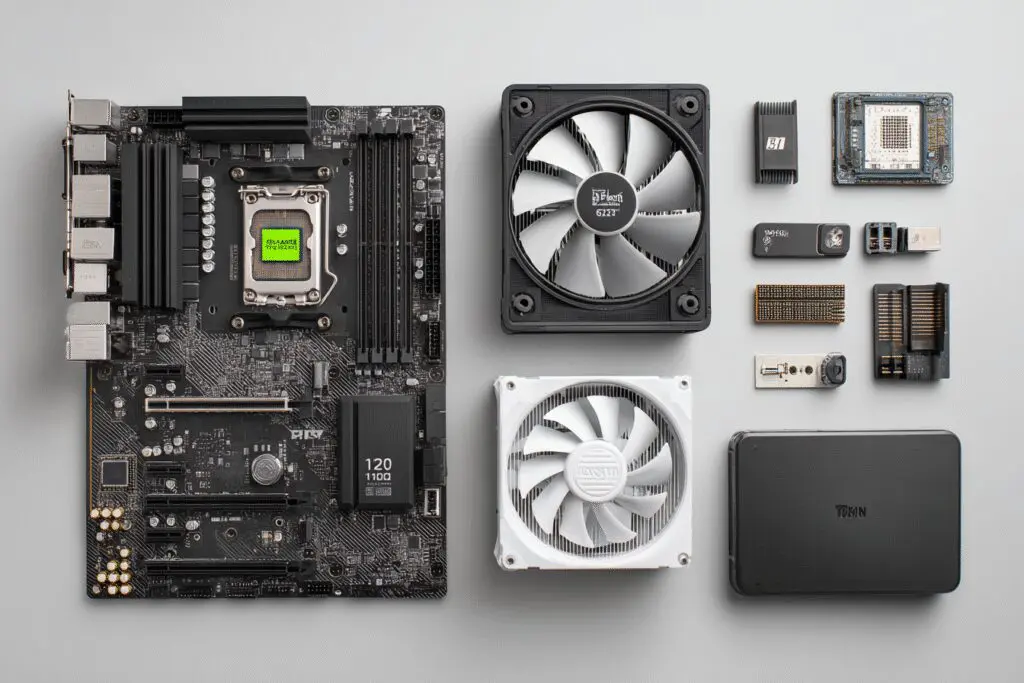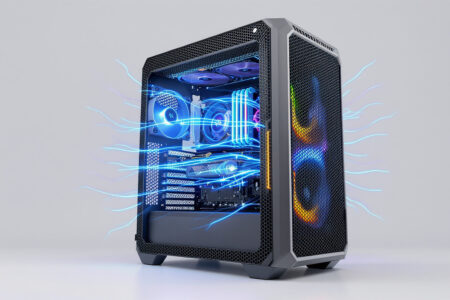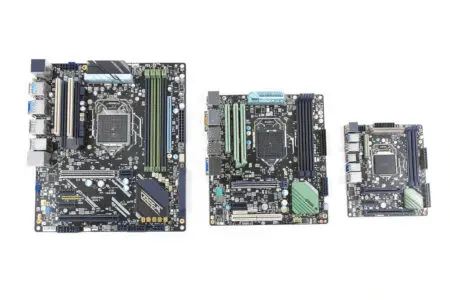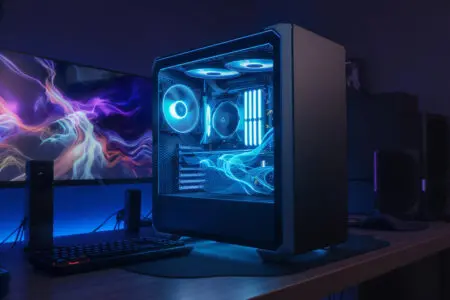Did you know that the global market for PC gaming hardware is projected to be worth over 65 billion dollars by 2027? That’s a staggering number of people deciding to take control of their gaming experience. So, if you’re standing on the edge, wondering what parts do I need to build a gaming PC, you’re in good company. It feels like a rite of passage, doesn’t it? That thrilling, slightly terrifying leap into creating a machine that’s perfectly, uniquely yours.
I remember my first build. I had a pile of expensive boxes on my floor and a deep-seated fear that I was about to create the world’s most complicated paperweight. The journey from that pile of parts to a glowing, humming gaming rig was one of the most satisfying projects I’ve ever tackled.
This guide is here to cut through the noise. We’re going to break down every essential component, piece by piece, without the dense technical jargon. This is your clear, straightforward checklist for building a gaming PC.
More in Hardware Category
What is the Brain of the Computer? The Central Processing Unit (CPU)
First up is the Central Processing Unit, or CPU. Think of it as the tireless manager or the lightning-fast brain of your entire operation. In essence, it takes instructions from your programs, crunches the numbers, and tells every other part what to do. For gaming, a good CPU is crucial for running complex game logic, physics, and artificial intelligence smoothly.
I spent weeks agonizing over my first CPU choice. The classic debate, Intel or AMD, felt like choosing a side in a war that had no clear winner. Ultimately, the best choice is the one that fits your budget and performance goals for the games you want to play right now.
How Do I Choose Between Intel and AMD?
For years, this choice defined your build. Today, thankfully, both companies make absolutely fantastic processors for gaming. You can’t really make a “wrong” choice, but they do have slightly different strengths.
- Intel often has a slight edge in raw single-core performance, which can be beneficial in some games that don’t use a lot of cores.
- AMD frequently offers excellent value with strong multi-core performance, making their CPUs great for both gaming and other tasks like streaming or video editing.
Instead of getting bogged down in brand loyalty, the best approach is to look at current benchmarks. Find reviews that test the specific CPUs you’re considering with the latest games. This gives you real-world data, not just marketing hype.
Do I Need to Worry About “Cores” and “Threads”?
You’ll see these terms everywhere. To put it simply, think of a core as an individual processor. More cores allow the CPU to handle more tasks at the same time. This is why a CPU with eight cores is generally better at multitasking than one with four.
Threads are a bit more complex, but you can imagine them as virtual lanes for information within each core, helping to manage tasks more efficiently. If you want a deeper, yet still understandable dive into how these little marvels work, there’s a fantastic explanation from Stanford University that breaks it all down. For modern gaming, aiming for a CPU with at least 6 cores and 12 threads is a safe bet that will keep you running smoothly for years to come.
What Part Makes My Games Look So Good? The Graphics Processing Unit (GPU)
If the CPU is the brain, the Graphics Processing Unit (or graphics card) is the soul. This is the component that takes all the data from the CPU and turns it into the beautiful, moving images you see on your screen. For a gaming PC, the GPU is unequivocally the most important part. It has the single biggest impact on your in-game performance, determining whether you’re playing at a cinematic 120 frames per second or a choppy slideshow.
I’ll never forget the moment I upgraded from a PC with integrated graphics (which uses the CPU to handle visuals) to one with a dedicated GPU. The game I was playing, which had previously run on the lowest settings, suddenly came to life on “Ultra.” It was like seeing in color for the first time. This is where you should allocate a significant portion of your budget.
How Much VRAM Do I Actually Need for Gaming?
VRAM, or Video RAM, is the GPU’s own dedicated, ultra-fast memory. It’s used to store high-resolution textures, models, and other visual assets that need to be accessed instantly. Running out of VRAM can cause stuttering and poor performance.
- 1080p Gaming: 8GB of VRAM is a great starting point and will handle most current titles comfortably.
- 1440p Gaming: 12GB of VRAM is becoming the new standard, giving you plenty of headroom for higher-resolution textures.
- 4K Gaming: 16GB of VRAM or more is highly recommended to ensure a smooth experience without compromises.
Is NVIDIA or AMD Better for Graphics Cards?
Just like the CPU battle, this is another classic rivalry. Both NVIDIA and AMD produce incredible GPUs, and the “best” one often comes down to price and features at any given time.
NVIDIA is well-known for its robust Ray Tracing performance and its AI-powered DLSS technology, which can boost frame rates significantly. On the other hand, AMD offers competitive raw performance, often at a great price, and its FSR technology is an open-source alternative to DLSS that works on a wider range of cards. Again, the best advice is to check current video reviews and benchmarks for the games you love to play.
Where Do All the Parts Connect? The Motherboard
The motherboard is the central nervous system of your PC. It’s a large circuit board where every single component plugs in and communicates with every other component. Choosing a motherboard can feel overwhelming because of all the sockets, slots, and acronyms. However, the most important factor is simply compatibility.
I almost made a catastrophic mistake on my first build. I had my AMD processor picked out and was seconds away from buying a motherboard made for an Intel CPU. They physically would not have fit together. That would have been a very expensive, very frustrating lesson. Always, always double-check that your motherboard’s “socket type” matches your chosen CPU.
What Do Motherboard Sizes Like ATX, Micro-ATX, and Mini-ITX Mean?
This is what’s known as the “form factor,” and it’s just a standardized size. This determines which PC cases it will fit into.
- ATX: This is the standard, full-size motherboard. It offers the most slots for RAM, storage drives, and other expansion cards.
- Micro-ATX: A slightly shorter, more compact version. It has fewer expansion slots but is perfect for smaller, more budget-friendly builds.
- Mini-ITX: This is a tiny motherboard designed for very small, shoebox-sized PCs. It’s amazing for portability but often comes with compromises, like having only two RAM slots.
What Features Should I Look for on a Motherboard?
Beyond the size and CPU socket, there are a few key features you’ll want to check for. These determine what other parts you can use.
- RAM Slots: Most ATX and Micro-ATX boards have four, while Mini-ITX boards have two.
- PCIe Slots: This is where your graphics card goes. You just need one main one, labeled as a “PCIe x16” slot.
- M.2 Slots: These are small slots for the fastest type of storage drives. Having at least one or two is highly desirable.
- Rear I/O (Input/Output): Check the back of the board for the number and type of USB ports (including faster USB 3.2 or USB-C), audio jacks, and network ports you need.
How Does My Computer Remember Things? Random Access Memory (RAM)
Random Access Memory, or RAM, is your computer’s short-term memory. Think of it like your physical desk space. When you’re working on something—playing a game, browsing the web, listening to music—all the active data is placed on your desk for quick access.
The more RAM you have, the bigger your desk is. Consequently, you can have more programs and files open at once without everything slowing to a crawl. When you run out of RAM, your computer has to start shuffling things back and forth from your much slower long-term storage, which causes stuttering and lag.
How Much RAM is Enough for a Gaming PC in 2025?
For a pure gaming machine, the recommendations are quite clear.
- 16GB: This is the current sweet spot. It’s enough to run virtually any modern game smoothly while also having a few background applications open like Discord or a web browser.
- 32GB: This is a fantastic choice for future-proofing your build. It also provides a significant benefit if you do more than just game, such as streaming your gameplay, video editing, or running lots of programs at once.
What is RAM Speed (MHz) and Does it Matter?
Yes, it absolutely matters, especially if you choose an AMD CPU, which tends to benefit more from faster RAM. RAM speed is measured in megahertz (MHz). Alongside speed, you’ll also see “DDR4” and “DDR5.” This refers to the generation of the RAM. DDR5 is the newer, faster standard, but you need a compatible motherboard and CPU to use it. When buying RAM, always check your motherboard’s specifications to see what speeds and types it supports.
Where Are My Games and Files Actually Stored? The Storage Drive
If RAM is the computer’s short-term memory, the storage drive is its long-term memory. This is the filing cabinet where your operating system, all your games, photos, and documents are kept permanently, even when the power is off.
Should I Get a Hard Disk Drive (HDD) or a Solid State Drive (SSD)?
This isn’t even a debate anymore. You absolutely must have a Solid State Drive (SSD) as your primary drive. The difference in speed is breathtaking. I remember the first time I booted a computer with an SSD; the Windows login screen appeared in under ten seconds. On my old Hard Disk Drive (HDD), I could go make a cup of coffee in the time it took to boot up.
HDDs are mechanical drives with spinning platters, while SSDs use flash memory, like a giant USB stick. An SSD will make your entire system feel faster, from starting up the PC to loading new levels in a game. You can still use a large, inexpensive HDD as a secondary drive for mass storage of files that don’t need to be accessed quickly, but your OS and favorite games belong on an SSD.
What is an NVMe M.2 SSD and Why Does Everyone Want One?
This is the current king of storage. An NVMe M.2 drive is a specific type of SSD that looks like a small stick of RAM. It plugs directly into a dedicated M.2 slot on the motherboard, eliminating the need for any extra power or data cables.
- Blazing Speed: They are significantly faster than older, SATA-based SSDs.
- Simplicity: No extra cables means a cleaner build and slightly better airflow.
- Compact Form: Their tiny size is perfect for any build.
If your motherboard has an M.2 slot, using an NVMe drive is the best possible choice for your main storage.
How Do I Get Power to All These Components? The Power Supply Unit (PSU)
The Power Supply Unit is the unsung hero of every PC build. It’s the component that takes the AC power from your wall outlet and converts it into the precise DC voltages that all of your delicate components need to run. It is tempting to save money here, but please don’t. A cheap, low-quality PSU is the one part that can fail and take every other component in your system with it.
A friend of mine learned this the hard way. He built a beautiful rig with a top-tier graphics card but powered it with a generic, unrated PSU. A few months later, it failed, and the resulting power surge fried his motherboard and GPU. A good power supply isn’t just a part; it’s insurance for your entire investment.
What Does the 80 Plus Rating (Bronze, Gold, etc.) Mean?
This is a certification for energy efficiency. An “80 Plus Bronze” rated PSU, for example, is guaranteed to be at least 82% efficient at converting AC to DC power. The rest is lost as heat. Higher ratings (Silver, Gold, Platinum, Titanium) are progressively more efficient. For most gaming builds, a unit with an 80 Plus Bronze or Gold rating from a reputable brand is an excellent choice.
How Many Watts Do I Need for My Power Supply?
The wattage you need depends entirely on the parts you’ve chosen, mainly the CPU and GPU. A great way to get a solid estimate is to use an online PSU calculator. Websites like PCPartPicker automatically calculate your system’s estimated power draw as you add components. As a general rule, it’s wise to choose a PSU that offers about 150-200 watts more than your system’s peak estimated usage. This gives you comfortable headroom for future upgrades and ensures the PSU isn’t always running at its maximum load.
Where Do I Put All These Parts? The PC Case
Finally, you need a home for all these components. The PC case is more than just a metal box; it defines your PC’s aesthetic, dictates how easy it is to build in, and, most importantly, plays a massive role in cooling.
I used to think the case didn’t matter much. Then I tried to build in a cheap, flimsy case with sharp metal edges and zero room for cable management. My hands and my patience were shredded by the end of it. A good case is a joy to work in, while a bad one can turn your build into a nightmare. Good airflow, achieved through smart design and included fans, is also critical for keeping your components cool and performing their best.
What Should I Look for When Choosing a PC Case?
- Compatibility: First and foremost, make sure your motherboard form factor (ATX, Micro-ATX, etc.) will fit. You also need to check the “GPU clearance” to ensure your graphics card isn’t too long to fit inside.
- Airflow: Look for cases with a mesh front panel. This allows for much better air intake compared to solid front panels, leading to lower temperatures.
- Cable Management: Features like rubber grommets, tie-down points behind the motherboard, and a PSU shroud (a cover for the power supply) make it infinitely easier to hide cables for a clean look and unobstructed airflow.
- Your Personal Style: This is the part of the PC you’ll be looking at every day. Whether you want a sleek, minimalist black box or a glass-paneled showcase with RGB lighting, choose something you love.
How Do I Stop My Expensive Parts from Overheating? CPU and System Cooling
High-performance components generate a lot of heat. Heat is the enemy of performance. If your parts get too hot, they will automatically slow themselves down (a process called “thermal throttling”) to prevent damage. Therefore, effective cooling is not optional; it’s essential.
Do I Need to Buy a Separate CPU Cooler?
Many CPUs, especially on the lower to mid-range, come with a “stock cooler” included in the box. For basic gaming and everyday use, these are generally adequate. They get the job done. However, they can also get quite loud when the CPU is working hard, sounding like a tiny jet engine.
If you buy a higher-end CPU (which often don’t include a cooler) or if you plan on “overclocking” (pushing your CPU to run faster than its factory settings), you will need to buy a better, aftermarket CPU cooler. Even for a standard build, an inexpensive tower air cooler is a fantastic upgrade that will run much quieter and keep your CPU cooler than the stock option.
What’s the Difference Between Air Cooling and Liquid Cooling (AIO)?
- Air Cooler: This is the traditional option. It consists of a metal heatsink with fins that draw heat away from the CPU, and a fan that blows air across the fins to dissipate the heat. They are simple, very reliable, and can be incredibly effective.
- AIO (All-In-One) Liquid Cooler: This is a sealed, pre-filled liquid cooling loop. It uses a pump to circulate liquid over the CPU to a radiator, where fans then cool the liquid down. AIOs can offer superior cooling performance for very high-end CPUs and often provide a cleaner, more modern look inside the case. However, they are more expensive and add more points of potential failure (the pump and fittings) compared to a simple air cooler.
Conclusion: The Final Part is You
And there you have it. That is the complete list of every core part you need to build a powerful gaming PC tower. It seems like a lot when you lay it all out, but think of it as a puzzle. Each piece has a specific place to go, and once you have them all, the fun part of putting them together begins.
Building a PC is one of the most rewarding tech projects you can tackle. You’ll learn exactly how these incredible machines work, and you’ll end up with a computer that is more powerful and less expensive than a pre-built equivalent. Take your time, watch some video build guides before you start, and enjoy the process. That moment you press the power button for the first time and it all lights up exactly as it should… there’s nothing else quite like it. Good luck with your build!
Frequently Asked Questions – What Parts Do I Need to Build a Gaming PC

How do I ensure my power supply and cooling system are adequate for my build?
Select a power supply with enough wattage (650-850W for most gaming PCs) and at least an 80 Plus Bronze rating for efficiency. For cooling, consider a reliable air or liquid cooler that fits your CPU, and ensure your case has good airflow with mesh panels or adequate ventilation to keep components cool.
What should I consider when choosing a motherboard?
Choose a motherboard that is compatible with your CPU socket type and has enough slots for RAM, storage drives, and other expansion cards. The size of the motherboard, such as ATX, should fit your case, and it should support your desired features.
Why is the graphics card so important in a gaming PC?
The graphics card, or GPU, is crucial because it renders the images you see on your screen. A powerful GPU allows you to play games with high-quality graphics at higher resolutions, making your gaming experience more immersive.
How do I choose the right CPU for my gaming PC?
When selecting a CPU, look for a balance between number of cores and clock speed. A 6-core CPU from Intel or AMD is a good start. It should also be compatible with your motherboard’s socket type to ensure proper fit and performance.
What are the essential core components needed to build a gaming PC?
The essential core components for a gaming PC include the CPU, graphics card (GPU), motherboard, RAM, storage drives, power supply, case, and CPU cooling system. These parts work together to ensure your PC runs games smoothly and efficiently.




